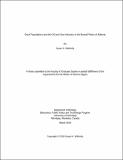Duck Populations and the Oil and Gas Industry in the Boreal Plains of Alberta
Metadata
Show full item recordAuthor
Witherly, Susan
Date
2018-03Citation
Witherly, Susan. Duck Populations and the Oil and Gas Industry in the Boreal Plains of Alberta; a thesis submitted in partial fulfillment of the requirements for the Master of Science degree [in] Bioscience, Public Policy and Technology. Winnipeg, Manitoba, Canada: University of Winnipeg, 2018.
Abstract
The boreal forest of northern Alberta supports a large portion of North America’s breeding duck population in addition to being an area of importance to the petroleum industry. Breeding duck surveys in the Boreal Plains ecozone show several ground nesting species are in decline while cavity and over-water nesters are showing both positive and negative population trends since the 1970s. Industry has been identified as a limiting factor that may be influencing duck populations and species composition in the region, but there has been limited empirical research to test this assertion. The objectives of this research were to (1) assess the hypothesis that as aerial extent and activity associated with industry increases, breeding waterfowl populations will decrease over the same time period and (2) determine the best climate data aggregations when modelling industrial effects on duck populations. Mixed effects logistic regression models were used to analyse relationships between breeding duck pair counts and a combination of climate, environmental, landscape, and industry variables. Top models showed consistent results across nesting guilds, including a small, negative relationship between breeding pairs and cumulative areas of petroleum infrastructure, and a positive relationship between both cumulative infrastructure edge and industrial activity with breeding pairs. The impact of using different seasonal classifications for understanding relationships between breeding duck populations and industrial development was examined using no climate data (null), and annual, two, four, and five seasons. Predictions of duck densities across gradients of oil and gas infrastructure and activity were generated using models fit with different seasonal aggregations. Different seasonal aggregations showed similar patterns for relationships between industry variables and breeding duck density but the presence of industry variables in models did vary by seasonal classification. Variation was also observed between nesting guild and industry measure for predicted duck pair densities.

